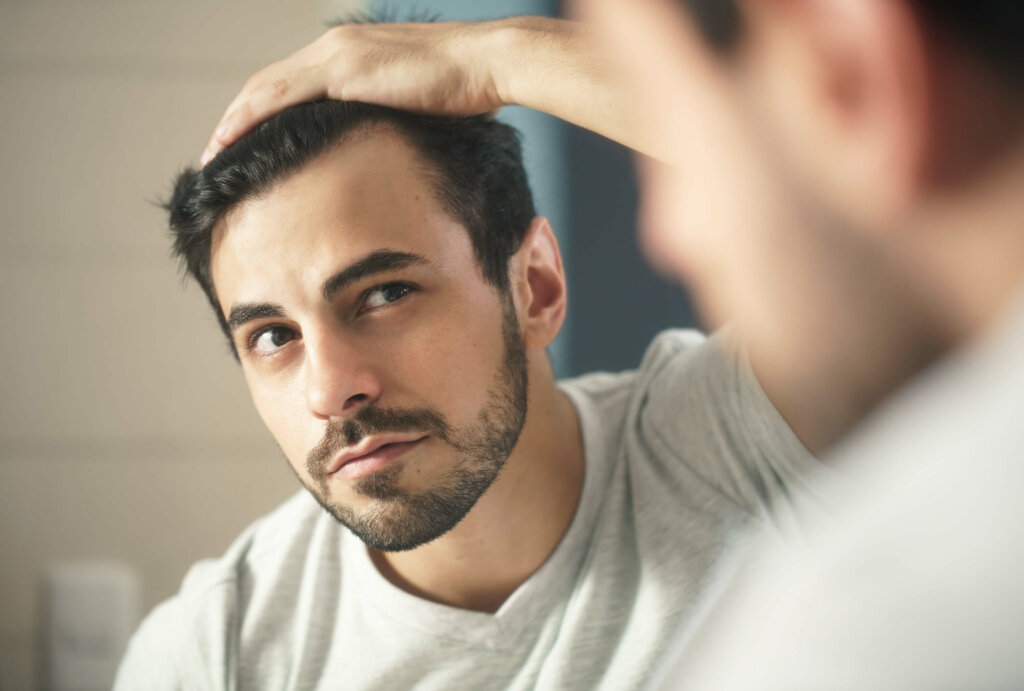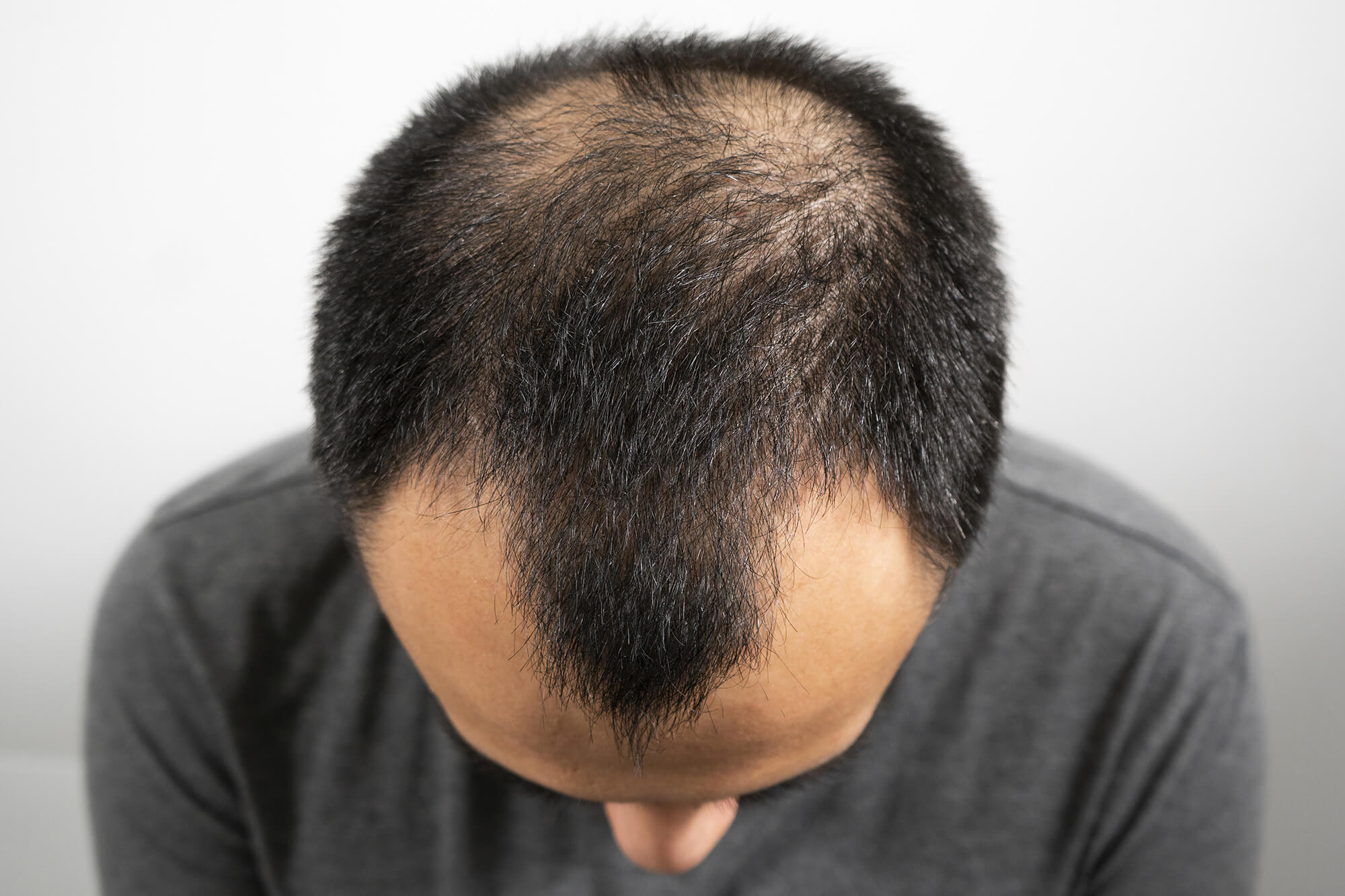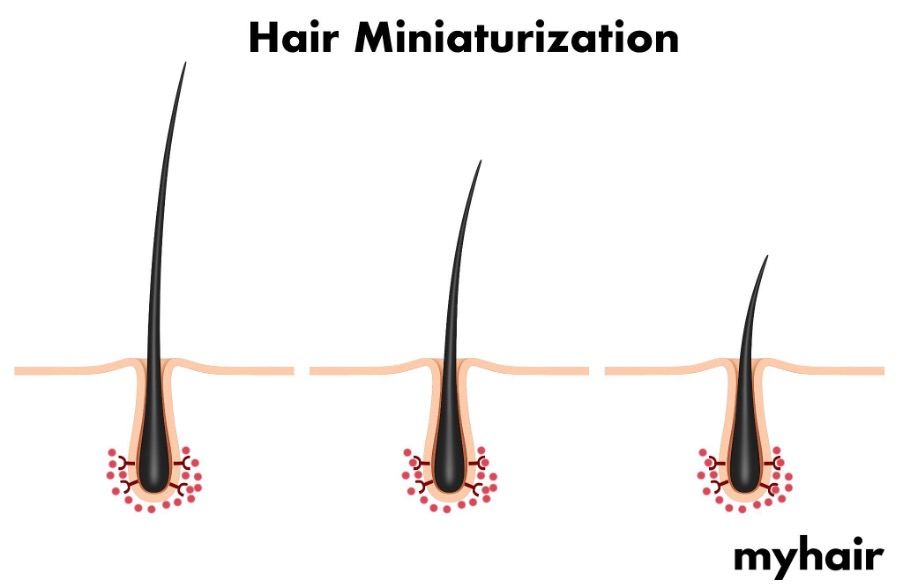If you grew up with a balding father, uncle, or neighbor, you probably spent a good portion of your childhood wondering why men go bald and if you would go bald, too. Chances are that those people had androgenic alopecia, which is also known as male pattern hair loss.
Androgenic alopecia is the primary cause of baldness. According to the American Hair Loss Association, this condition accounts for more than 95 percent of hair loss in men. Fortunately, this condition has a wide variety of treatment options.
It is possible to go bald from other hair loss conditions, too. They’re just much rarer, and tend to be much harder to treat.
Androgenic alopecia: the most common cause of baldness
Men can go bald for many reasons. The most common cause is androgenic alopecia, which is also commonly called pattern hair loss. This condition is caused by a mixture of genetic and hormonal factors.
Will I go bald at a certain age?
When you’re young, you usually see hair loss as an age-related phenomenon — which is partially correct. Men are more likely to lose hair as they age.
But if you have androgenic alopecia, the underlying genetics-and-hormones combination that causes this condition will determine the age you go bald. You could go bald in your early 20s, or might not until you’re well into your senior years.
In general, though, the American Hair Loss Association says that:
- 25 percent of American men start seeing symptoms of androgenic alopecia by age 21
- By age 35, two-thirds of American men experience some amount of hair loss
- By age 50, 85 percent of American men have noticeably thinning hair
Typical stages of pattern hair loss
Androgenic alopecia is a progressive condition that typically occurs over many years. And in fact, according to a study in the Journal of Cutaneous and Aesthetic Surgery, pattern hair loss usually occurs in defined stages.
When androgenic alopecia starts to affect the scalp, the first changes you’ll see are around your hairline. Hair loss may not be particularly apparent at first. Unfortunately, it’s normal not to notice any changes until they become more obvious. As hair loss progresses, you might feel like your forehead is getting bigger, or your hairline is receding or changing.

A receding or patchy hairline is one of the first noticeable signs of androgenic alopecia.
The next stages of hair loss occur over defined areas. You’ll specifically notice hair loss around your temples and the crown of your head. Over time, hair in these areas will thin and grow more sparsely. These are the first areas where hair will stop growing entirely.

When androgenic alopecia starts to cause hair loss at the crown, the hair there stops growing back.
As androgenic alopecia progresses, you’ll end up with the typical ‘M’ shape of hair at your hairline and no hair at the very top of your head. Eventually, the remaining hair at the top of your head will start to thin and disappear, as well.

An ‘M’ shaped hairline is typical as pattern hair loss progresses.
Most people end up with a thin band of hair separating the front and crown of their head, which is also lost over time. If your hair loss is allowed to progress to this point, you’ll effectively be bald.

Androgenic alopecia doesn’t affect the sides or lower back of the head.
Of course, not all of the hair on your head is lost when you have androgenic alopecia. The hair at the lower back of your head and a thin strip above your ears is never affected by this condition.
Why does hair stop growing back?
Throughout the various stages of androgenic alopecia, your hair follicles undergo changes. A study in the Journal of Cosmetic Dermatology says that they’re actually shrinking over time. This is known as hair follicle miniaturization, and is the reason your hair gets progressively thinner as pattern hair loss progresses. Miniaturization occurs when a hormone, DHT (dihydrotestosterone), binds to hair follicles.
Eventually, your hair follicles either disappear or turn into vellus hairs. Vellus hairs are the fine, peach fuzz hairs you have on your face and other parts of your body. Regular hair strands, called terminal hairs, are no longer produced.
What is the purpose of balding?
If you’re wondering why humans evolved this way, the answer is that no one truly knows. But in 2008, Peter Kabai, associate professor at Szent István University in Hungary, published his own theory in the Medical Hypotheses journal. After going bald himself, Kabai realized that androgenic alopecia may have evolved to protect men from prostate cancer.
How would going bald help with cancer? According to a review in Advances in Experimental Medicine and Biology, low vitamin D levels are often associated with aggressive prostate cancer.
The easiest way to get more of this nutrient is to spend time outside, since vitamin D can be synthesized from sunlight. And if you were really trying to increase your levels, getting sun directly on your scalp would certainly help, and losing hair would certainly increase your sun (and UV) exposure.
“Tens of thousands of years ago in Europe [balding] might have helped those individuals to receive more UV radiation and produce more vitamin D.”
At the end of the day, you might not want to be so upset about balding. If there’s any chance you have even distant family from colder climates, there’s a good chance androgenic alopecia helped your ancestors survive.
Treatments for androgenic alopecia
As the most common cause of hair loss and baldness, androgenic alopecia also has the widest variety of treatment options. You’ll be glad to know that the FDA has approved three hair loss treatments that can stop the progression of pattern hair loss and stimulate hair regrowth.
1. Minoxidil
Minoxidil is a topical hair loss treatment that’s usually sold as a liquid serum or a foam. According to a study published in the Drugs Journal, scientists still aren’t completely certain how minoxidil works.
Minoxidil might promote the release of hair-related growth factors, regulate hormones, and reduce inflammation. What’s known for certain is that it works as a vasodilator, increasing blood flow to the scalp and hair follicles.
Minoxidil is available in a wide variety of concentrations, usually ranging from 1 to 10 percent. However, be aware that only the 2 and 5 percent liquids and foams are FDA-approved for androgenic alopecia. To treat this condition, the 2 or 5 percent concentration solutions of minoxidil usually need to be applied twice a day.
Other products, like minoxidil shampoo and minoxidil creams, are also produced. These items are fairly new to the market and haven’t been proven to be effective in stopping the progression of androgenic alopecia. At the moment, 5 percent minoxidil foam or serum are considered to be the most effective products available.
2. Finasteride
Finasteride is an oral medication that’s used to treat various health issues, including androgenic alopecia. It works as a DHT (dihydrotestosterone) blocker, reducing the amount of testosterone that’s converted into DHT. DHT is the primary hormonal component responsible for male pattern hair loss.
Finasteride is generally thought to be very effective at stopping the progression of androgenic alopecia. However, unlike minoxidil, which has few side effects, finasteride’s side effects are practically infamous.
According to a review in the Journal of Drugs and Dermatology, this drug is particularly well known for causing problems like testicular pain, gynecomastia (male breast tissue growth), erectile dysfunction, and even infertility. The Drugs Journal says that some side effects can be more likely based on age.
Since finasteride needs to be taken on a daily basis, the array of side effects it can cause can be a serious issue. Of course, it’s possible for people’s bodies to get used to the drug. But this can take years and have a huge toll on self-esteem, mental health, and overall wellness. And not all side effects, like gynecomastia, are easily reversible.
An alternative version of this product, topical finasteride, is currently being developed as an alternative hair loss treatment. Although topical finasteride isn’t yet available to the public, the Journal of Drugs and Dermatology study reported that it causes much less serious side effects and is still capable of stimulating hair regrowth.
3. Low level laser therapy (LLLT)
Low level laser therapy is a hair loss treatment done by using a light emitting device in the form of a comb, hairbrush, or headband. This device, which emits red, near-infrared, or infrared laser light, is thought to stimulate dormant hair follicles and promote hair regrowth. A study in the Lasers in Medical Science journal says that LLLT might also work by increasing the number of hair follicles on your scalp, reducing inflammation, and prolonging the duration of the anagen phase of the hair growth cycle.
Out of all the FDA-approved options for hair loss, LLLT is the newest. You can go into a clinic for treatments or purchase your own device. The main downside to LLLT is cost: It’s the least affordable option compared to minoxidil and finasteride.
4. Hair transplants
Hair transplants aren’t one of the FDA-approved treatments for pattern hair loss, but they are an option — especially for people who have let their hair loss progress past a certain stage. At the moment, the most popular hair transplants are called FUE (follicular unit extraction) and FUT (follicular unit transplantation).
In both FUE and FUT, follicles from a part of your head that’s unaffected by hair loss are transplanted to the area where you’re balding. However, FUE is less invasive than FUT.
FUE involves the extraction and transplantation of singular hair follicles, which means that any scarring is minimal or even non-existent. In contrast, during FUT, a strip of skin from the back of the scalp is removed. Follicles are extracted from this region and transplanted back onto your head. Because of the skin extracted, FUT leaves people with a distinct, linear scar.
Other causes of baldness
Various other conditions can also lead to baldness or permanent hair loss. These conditions are usually autoimmune, and most are a type of scarring alopecia. Fortunately, these other forms of hair loss are far less common than androgenic alopecia.
Scarring alopecias
According to an article in Current Problems in Dermatology, scarring alopecias are broken down into two categories. There are forms that directly affect hair follicles, and those that affect the skin and destroy hair follicles as a consequence.
A study in the journal Actas Dermo-Sifiliográficas says that scarring alopecias cause hair follicles to be replaced with scar tissue or collagen, destroying the follicle’s ability to produce hair and causing permanent hair loss. Scarring alopecias include conditions like:
- Chronic cutaneous lupus erythematosus
- Lichen planopilaris
- Pseudopelade of Brocq
- Central centrifugal cicatricial alopecia
- Alopecia mucinosa
- Keratosis follicularis spinulosa decalvans
- Folliculitis decalvans
- Dissecting cellulitis
- Acne keloidalis nuchae
- Acne necrotica varioliformis
- Erosive pustular dermatosis
Alopecia areata
Alopecia areata is an autoimmune condition that may or may not cause baldness. This condition is known for causing patchy circles of hair loss. However, for some people, alopecia areata affects the entire head, causing complete baldness. In others, it causes hair loss all over their body.
A study in the Journal of Cosmetics, Dermatological Sciences and Applications says that alopecia areata affects about 2 percent of people. It manifests in everyone differently, and many people never even require a hair loss treatment. Unfortunately, others may experience lifelong recurrences or permanent hair loss.
Treatments for autoimmune hair loss
In contrast to androgenic alopecia, hair loss triggered by an autoimmune condition can be a lot more sudden and extreme. If you think you’re experiencing this type of hair loss, it’s best to consult a doctor right away. Autoimmune conditions are generally treated with corticosteroids, though minoxidil is sometimes also used to help stimulate hair regrowth.
Hair loss doesn’t always cause baldness
Although there are many types of hair loss, you should know that not all of them lead to baldness. For example, it’s possible to experience hair loss due to stress. A study in the Indian Journal of Dermatology, Venereology, and Leprology says that the stressor can be any number of things, from a serious illness to a sudden death in the family.
Stress-related hair loss, known as telogen effluvium, often occurs all over the head in a diffuse manner. Hair doesn’t usually fall out instantly. Instead, it’s typical to see increased hair shedding a few months after the event that caused the stress.
After a while – and assuming the source of stress has passed – the lost hair will usually grow back. Although it may take some time to regrow a lot of lost hair, it’s not a permanent problem.
Unlike with androgenic alopecia or scarring autoimmune conditions, hair follicles aren’t permanently affected by stress. They may need a bit of support and stimulation through a treatment like minoxidil, but they’re still capable of producing new hair strands.
Takeaway
Androgenic alopecia is the most common cause of balding, affecting the vast majority of American men at some point in their lives. Fortunately, this condition occurs over many years. This means that you can stop its progression and even reverse your hair loss if you start a treatment early enough. The FDA currently recommends treatment options like minoxidil, finasteride, and low level laser therapy.
Other — though not all — hair loss conditions can also lead to baldness. Conditions that lead to balding are often autoimmune and consequently have fewer treatment options. In some cases, like with scarring alopecias, hair loss can be permanent.





